service schedule SKODA SUPERB 2006 1.G / (B5/3U) Owner's Manual
[x] Cancel search | Manufacturer: SKODA, Model Year: 2006, Model line: SUPERB, Model: SKODA SUPERB 2006 1.G / (B5/3U)Pages: 281, PDF Size: 12.67 MB
Page 3 of 281
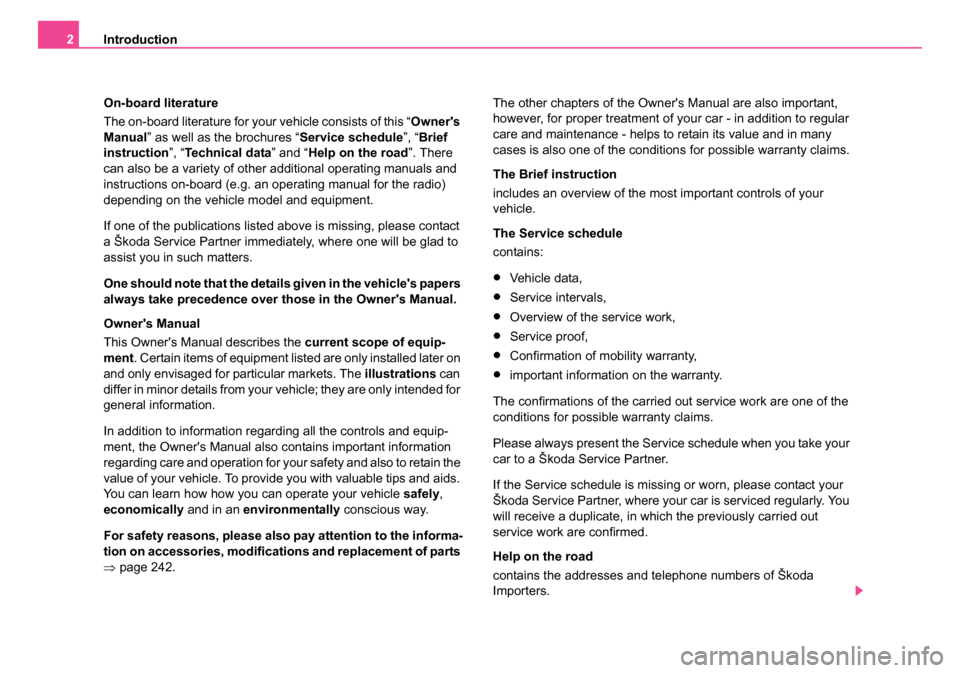
Introduction
2
On-board literature
The on-board literature for your vehicle consists of this “ Owner's
Manual” as well as the brochures “ Service schedule”, “Brief
instruction ”, “Te c h n i c a l d a t a ” and “Help on the road ”. There
can also be a variety of other additional operating manuals and
instructions on-board (e.g. an operating manual for the radio)
depending on the vehicle model and equipment.
If one of the publications listed above is missing, please contact
a Škoda Service Partner immediately, where one will be glad to
assist you in such matters.
One should note that the details given in the vehicle's papers
always take precedence over th ose in the Owner's Manual.
Owner's Manual
This Owner's Manual describes the current scope of equip-
ment . Certain items of equipment listed are only installed later on
and only envisaged for particular markets. The illustrations can
differ in minor details from your vehicle; they are only intended for
general information.
In addition to information regarding all the controls and equip-
ment, the Owner's Manual also contains important information
regarding care and operation for your safety and also to retain the
value of your vehicle. To provide you with valuable tips and aids.
You can learn how how you can operate your vehicle safely,
economically and in an environmentally conscious way.
For safety reasons, please also pay attention to the informa-
tion on accessories, modificati ons and replacement of parts
⇒ page 242. The other chapters of the Owner's Manual are also important,
however, for proper treatment of your car - in addition to regular
care and maintenance - helps to retain its value and in many
cases is also one of the conditions for possible warranty claims.
The Brief instruction
includes an overview of the most important controls of your
vehicle.
The Service schedule
contains:
•Vehicle data,
•Service intervals,
•Overview of the service work,
•Service proof,
•Confirmation of mobility warranty,
•important information on the warranty.
The confirmations of the carried out service work are one of the
conditions for possible warranty claims.
Please always present the Service schedule when you take your
car to a Škoda Service Partner.
If the Service schedule is missing or worn, please contact your
Škoda Service Partner, where your car is serviced regularly. You
will receive a duplicate, in which the previously carried out
service work are confirmed.
Help on the road
contains the addresses and telephone numbers of Škoda
Importers.
NKO B5 20.book Page 2 Monday, July 3, 2006 2:09 PM
Page 18 of 281
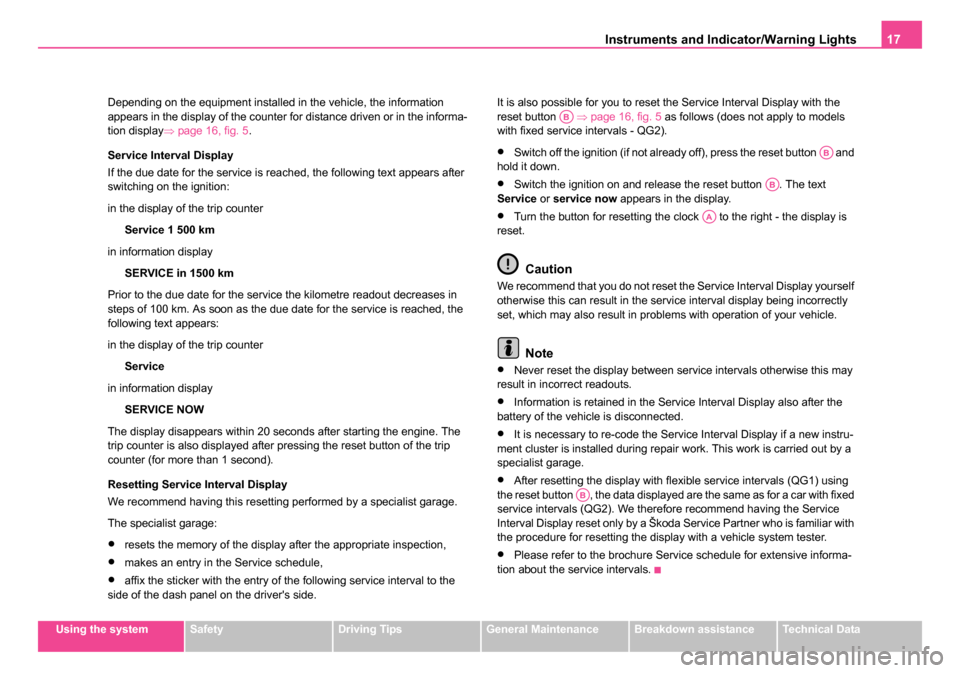
Instruments and Indicator/Warning Lights17
Using the systemSafetyDriving TipsGeneral MaintenanceBreakdown assistanceTechnical Data
Depending on the equipment installed in the vehicle, the information
appears in the display of the counter for distance driven or in the informa-
tion display
⇒page 16, fig. 5 .
Service Interval Display
If the due date for the service is reached, the following text appears after
switching on the ignition:
in the display of the trip counter Service 1 500 km
in information display SERVICE in 1500 km
Prior to the due date for the service the kilometre readout decreases in
steps of 100 km. As soon as the due date for the service is reached, the
following text appears:
in the display of the trip counter Service
in information display SERVICE NOW
The display disappears within 20 seconds after starting the engine. The
trip counter is also displayed after pressing the reset button of the trip
counter (for more than 1 second).
Resetting Service Interval Display
We recommend having this resetting performed by a specialist garage.
The specialist garage:
•resets the memory of the display after the appropriate inspection,
•makes an entry in the Service schedule,
•affix the sticker with the entry of the following service interval to the
side of the dash panel on the driver's side. It is also possible for you to reset the Service Interval Display with the
reset button
⇒page 16, fig. 5 as follows (does not apply to models
with fixed service intervals - QG2).
•Switch off the ignition (if not already off), press the reset button and
hold it down.
•Switch the ignition on and release the reset button . The text
Service or service now appears in the display.
•Turn the button for resetting the clock to the right - the display is
reset.
Caution
We recommend that you do not reset the Service Interval Display yourself
otherwise this can result in the service interval display being incorrectly
set, which may also result in problems with operation of your vehicle.
Note
•Never reset the display between service intervals otherwise this may
result in incorrect readouts.
•Information is retained in the Service Interval Display also after the
battery of the vehicle is disconnected.
•It is necessary to re-code the Service Interval Display if a new instru-
ment cluster is installed during repair work. This work is carried out by a
specialist garage.
•After resetting the display with flexible service intervals (QG1) using
the reset button , the data displayed are the same as for a car with fixed
service intervals (QG2). We therefore recommend having the Service
Interval Display reset only by a Škoda Service Partner who is familiar with
the procedure for resetting the display with a vehicle system tester.
•Please refer to the brochure Service schedule for extensive informa-
tion about the service intervals.
AB
AB
AB
AA
AB
NKO B5 20.book Page 17 Monday, July 3, 2006 2:09 PM
Page 31 of 281
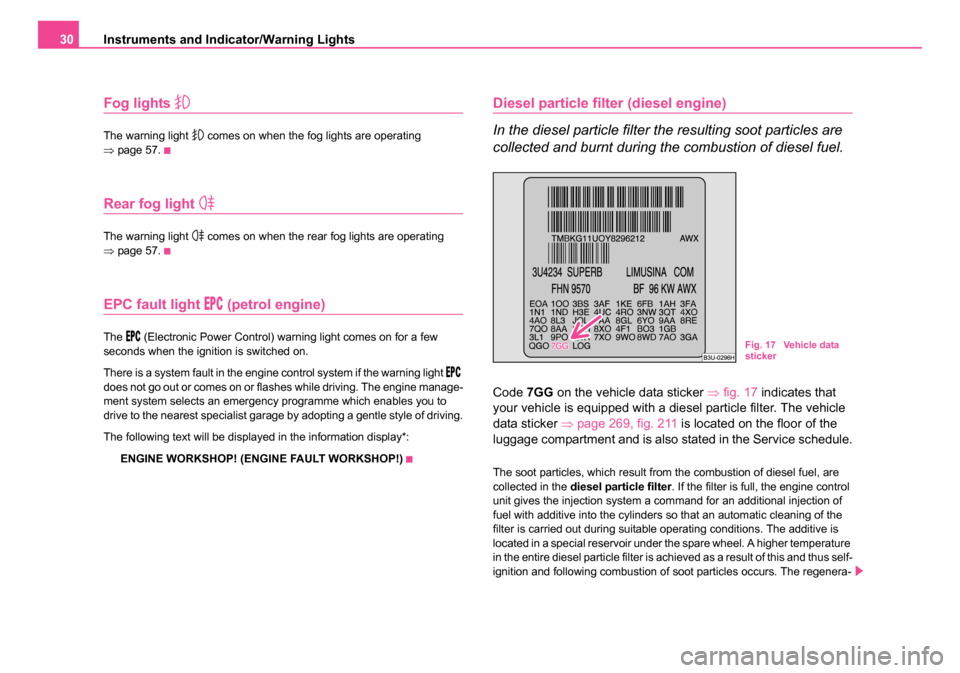
Instruments and Indicator/Warning Lights
30
Fog lights
The warning light comes on when the fog lights are operating
⇒ page 57.
Rear fog light
The warning light comes on when the rear fog lights are operating
⇒ page 57.
EPC fault light (petrol engine)
The (Electronic Power Control) warning light comes on for a few
seconds when the ignition is switched on.
There is a system fault in the engine control system if the warning light
does not go out or comes on or flashes while driving. The engine manage-
ment system selects an emergency programme which enables you to
drive to the nearest specialist garage by adopting a gentle style of driving.
The following text will be displayed in the information display*:
ENGINE WORKSHOP! (ENGINE FAULT WORKSHOP!)
Diesel particle filter (diesel engine)
In the diesel particle filter the resulting soot particles are
collected and burnt during the combustion of diesel fuel.
Code 7GG on the vehicle data sticker ⇒fig. 17 indicates that
your vehicle is equipped with a diesel particle filter. The vehicle
data sticker ⇒page 269, fig. 211 is located on the floor of the
luggage compartment and is also stated in the Service schedule.
The soot particles, which result from the combustion of diesel fuel, are
collected in the diesel particle filter . If the filter is full, the engine control
unit gives the injection system a command for an additional injection of
fuel with additive into the cylinders so that an automatic cleaning of the
filter is carried out during suitable operating conditions. The additive is
located in a special reservoir under the spare wheel. A higher temperature
in the entire diesel particle filter is achieved as a result of this and thus self-
ignition and following combustion of soot particles occurs. The regenera-
Fig. 17 Vehicle data
sticker
NKO B5 20.book Page 30 Monday, July 3, 2006 2:09 PM
Page 197 of 281
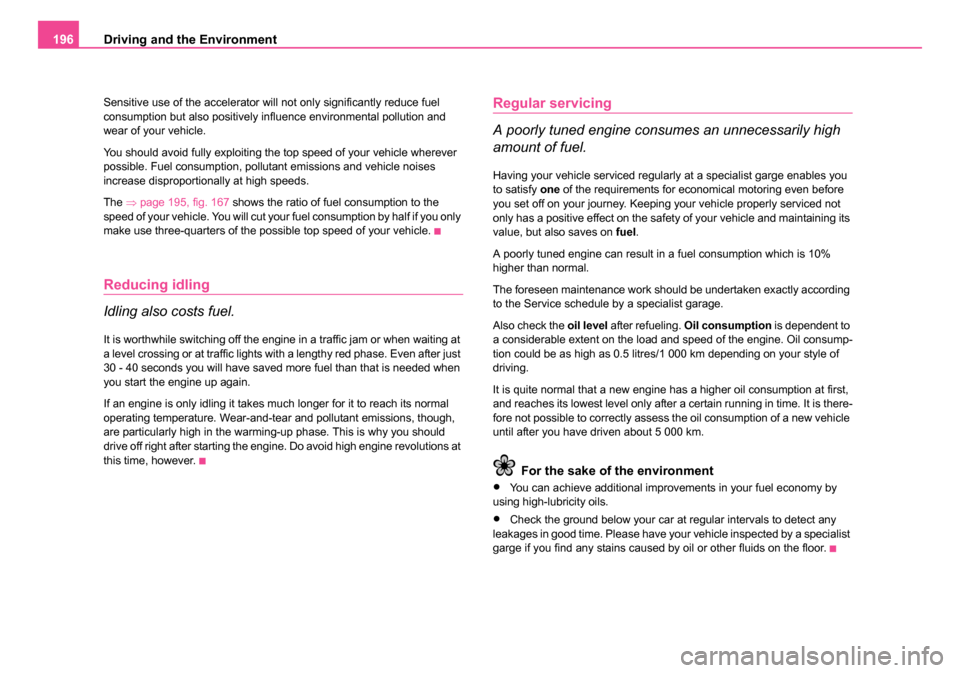
Driving and the Environment
196
Sensitive use of the accelerator will not only significantly reduce fuel
consumption but also positively influence environmental pollution and
wear of your vehicle.
You should avoid fully exploiting the top speed of your vehicle wherever
possible. Fuel consumption, pollutant emissions and vehicle noises
increase disproportionally at high speeds.
The ⇒page 195, fig. 167 shows the ratio of fuel consumption to the
speed of your vehicle. You will cut your fuel consumption by half if you only
make use three-quarters of the possible top speed of your vehicle.
Reducing idling
Idling also costs fuel.
It is worthwhile switching off the engine in a traffic jam or when waiting at
a level crossing or at traffic lights with a lengthy red phase. Even after just
30 - 40 seconds you will have saved more fuel than that is needed when
you start the engine up again.
If an engine is only idling it takes much longer for it to reach its normal
operating temperature. Wear-and-tear and pollutant emissions, though,
are particularly high in the warming-up phase. This is why you should
drive off right after starting the engine. Do avoid high engine revolutions at
this time, however.
Regular servicing
A poorly tuned engine consumes an unnecessarily high
amount of fuel.
Having your vehicle serviced regularly at a specialist garge enables you
to satisfy one of the requirements for economical motoring even before
you set off on your journey. Keeping your vehicle properly serviced not
only has a positive effect on the safety of your vehicle and maintaining its
value, but also saves on fuel.
A poorly tuned engine can result in a fuel consumption which is 10%
higher than normal.
The foreseen maintenance work should be undertaken exactly according
to the Service schedule by a specialist garage.
Also check the oil level after refueling. Oil consumption is dependent to
a considerable extent on the load and speed of the engine. Oil consump-
tion could be as high as 0.5 litres/1 000 km depending on your style of
driving.
It is quite normal that a new engine has a higher oil consumption at first,
and reaches its lowest level only after a certain running in time. It is there-
fore not possible to correctly assess the oil consumption of a new vehicle
until after you have driven about 5 000 km.
For the sake of the environment
•You can achieve additional improvements in your fuel economy by
using high-lubricity oils.
•Check the ground below your car at regular intervals to detect any
leakages in good time. Please have your vehicle inspected by a specialist
garge if you find any stains caused by oil or other fluids on the floor.
NKO B5 20.book Page 196 Monday, July 3, 2006 2:09 PM
Page 216 of 281
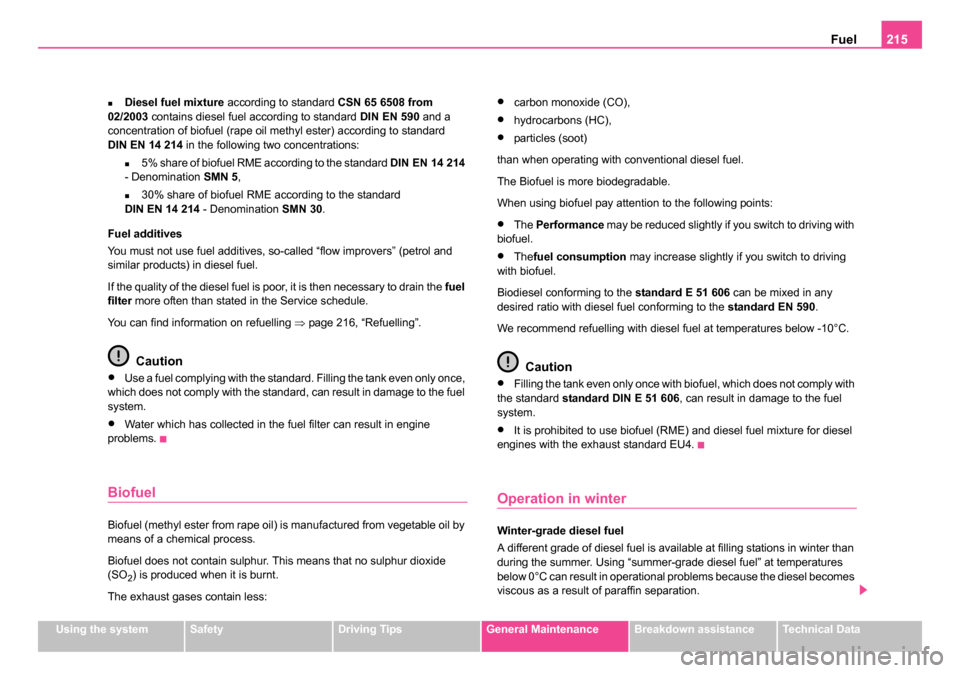
Fuel215
Using the systemSafetyDriving TipsGeneral MaintenanceBreakdown assistanceTechnical Data
�„Diesel fuel mixture according to standard CSN 65 6508 from
02/2003 contains diesel fuel according to standard DIN EN 590 and a
concentration of biofuel (rape oil methyl ester) according to standard
DINEN14214 in the following two concentrations:
�„5% share of biofuel RME according to the standard DINEN14214
- Denomination SMN 5,
�„30% share of biofuel RME according to the standard
DINEN14214 - Denomination SMN 30.
Fuel additives
You must not use fuel additives, so-called “flow improvers” (petrol and
similar products) in diesel fuel.
If the quality of the diesel fuel is poor, it is then necessary to drain the fuel
filter more often than stated in the Service schedule.
You can find information on refuelling ⇒page 216, “Refuelling”.
Caution
•Use a fuel complying with the standard. Filling the tank even only once,
which does not comply with the standard, can result in damage to the fuel
system.
•Water which has collected in the fuel filter can result in engine
problems.
Biofuel
Biofuel (methyl ester from rape oil) is manufactured from vegetable oil by
means of a chemical process.
Biofuel does not contain sulphur. This means that no sulphur dioxide
(SO
2) is produced when it is burnt.
The exhaust gases contain less:
•carbon monoxide (CO),
•hydrocarbons (HC),
•particles (soot)
than when operating with conventional diesel fuel.
The Biofuel is more biodegradable.
When using biofuel pay attention to the following points:
•The Performance may be reduced slightly if you switch to driving with
biofuel.
•The fuel consumption may increase slightly if you switch to driving
with biofuel.
Biodiesel conforming to the standard E 51 606 can be mixed in any
desired ratio with diesel fuel conforming to the standard EN 590.
We recommend refuelling with diesel fuel at temperatures below -10°C.
Caution
•Filling the tank even only once with biofuel, which does not comply with
the standard standard DIN E 51 606 , can result in damage to the fuel
system.
•It is prohibited to use biofuel (RME) and diesel fuel mixture for diesel
engines with the exhaust standard EU4.
Operation in winter
Winter-grade diesel fuel
A different grade of diesel fuel is available at filling stations in winter than
during the summer. Using “summer-grade diesel fuel” at temperatures
below 0°C can result in operational problems because the diesel becomes
viscous as a result of paraffin separation.
NKO B5 20.book Page 215 Monday, July 3, 2006 2:09 PM
Page 224 of 281
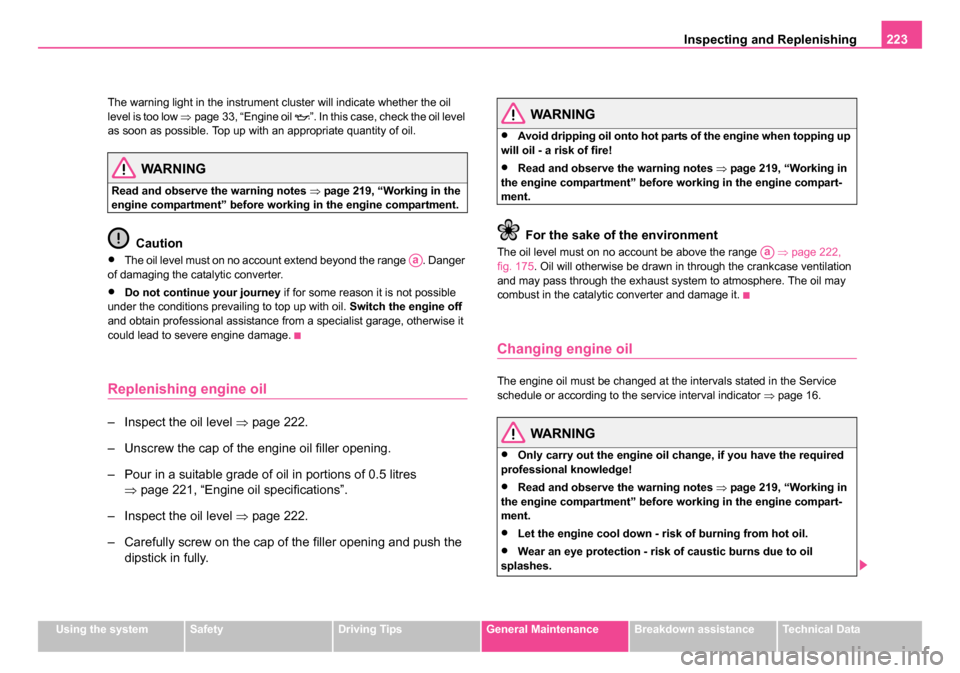
Inspecting and Replenishing223
Using the systemSafetyDriving TipsGeneral MaintenanceBreakdown assistanceTechnical Data
The warning light in the instrument cluster will indicate whether the oil
level is too low
⇒page 33, “Engine oil ”. In this case, check the oil level
as soon as possible. Top up with an appropriate quantity of oil.
WARNING
Read and observe the warning notes ⇒page 219, “Working in the
engine compartment” before working in the engine compartment.
Caution
•The oil level must on no account extend beyond the range . Danger
of damaging the catalytic converter.
•Do not continue your journey if for some reason it is not possible
under the conditions prevailing to top up with oil. Switch the engine off
and obtain professional assistance from a specialist garage, otherwise it
could lead to severe engine damage.
Replenishing engine oil
– Inspect the oil level ⇒page 222.
– Unscrew the cap of the engine oil filler opening.
– Pour in a suitable grade of oil in portions of 0.5 litres ⇒page 221, “Engine oil specifications”.
– Inspect the oil level ⇒page 222.
– Carefully screw on the cap of the filler opening and push the dipstick in fully.
WARNING
•Avoid dripping oil onto hot parts of the engine when topping up
will oil - a risk of fire!
•Read and observe the warning notes ⇒page 219, “Working in
the engine compartment” before working in the engine compart-
ment.
For the sake of the environment
The oil level must on no account be above the range ⇒page 222,
fig. 175 . Oil will otherwise be drawn in through the crankcase ventilation
and may pass through the exhaust system to atmosphere. The oil may
combust in the catalytic converter and damage it.
Changing engine oil
The engine oil must be changed at the intervals stated in the Service
schedule or according to the service interval indicator ⇒page 16.
WARNING
•Only carry out the engine oil change, if you have the required
professional knowledge!
•Read and observe the warning notes ⇒page 219, “Working in
the engine compartment” before working in the engine compart-
ment.
•Let the engine cool down - risk of burning from hot oil.
•Wear an eye protection - risk of caustic burns due to oil
splashes.
AaAa
NKO B5 20.book Page 223 Monday, July 3, 2006 2:09 PM
Page 270 of 281

General269
Using the systemSafetyDriving TipsGeneral MaintenanceBreakdown assistanceTechnical Data
Technical Data
General
Identification data
Vehicle data sticker
The vehicle data sticker ⇒fig. 211 is located on the floor of the luggage
compartment and is also stated in the Service schedule.
The vehicle data sticker contains the following data:
Vehicle identification number (VIN)
Vehicle type
Gearbox code, paint number, interior equipment number, engine
output, engine code
Partial description of the vehicle Vehicle identification number (VIN)
The vehicle identification number - VIN (vehicle body number) is stamped
onto the partition between the engine compartment and the passenger
compartment and on a sign on the lower left hand edge below the wind-
screen.
Engine number
The engine number is stamped into the engine block.
Type plate (production plate)
The type plate is affixed to the rear cross panel in the engine compartment
on the right looking in the direction of travel.
Vehicles for certain export countries do not have a type plate.
Sticker on inside of fuel filler flap
The sticker is affixed to the inside of the fuel filler flap. The sticker contains
the following data:•The prescribed types of fuel,
•Tyre size,
•Tyre pressure.
Note
•You will find the technical data of your vehicle in the separate brochure
"Technical Data".
•Please note that the information stated in the official vehicle registra-
tion documents always takes priority.
Fig. 211 Vehicle data
sticker
A1
A2
A3
A4
NKO B5 20.book Page 269 Monday, July 3, 2006 2:09 PM